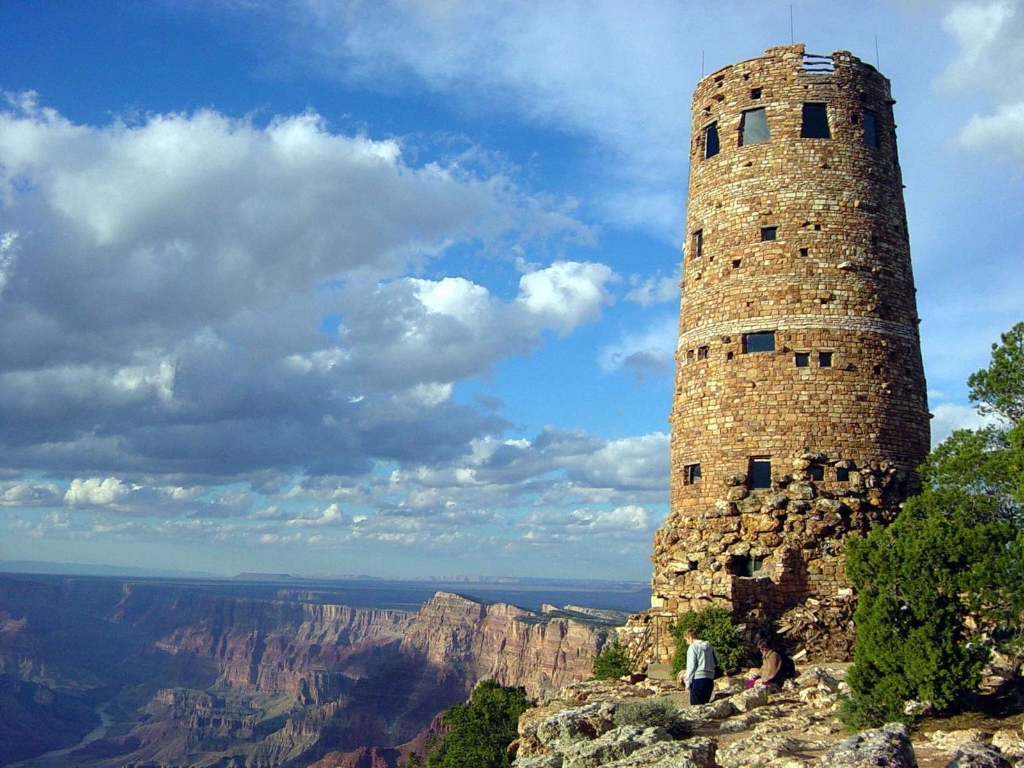
Hours of Operation
Desert View Watchtower Retail Store (View Room)
8 am to 6 pm Daily
- Cultural Handicraft Demonstrations take place in the View Room during spring, summer and fall. During the winter. demonstrations take place at the South Rim Visitor Center.
The upper floors of the tower are open, when staffing allows, from 8:20 am to 4:40 pm. Capacity is 25 people in the tower at one time. A ticket system admits 25 people with a 20 minute time limit.
- Tickets are 1st come 1st serve and admission is free to the public.
- You must be present to receive tickets, no tickets are held for future times.
- No guided tours are available at this time.
About the Watchtower
Desert View is the eastern-most developed area on the South Rim of the park.
Starting from the main parking area, a short .25 mile (.4 km) walk takes you past restrooms, the general store/market and the trading post. From there, the Watchtower is in plain view.
Recognized as a National Historic Landmark, the Watchtower was constructed in 1932. Architect Mary Colter’s design takes its influences from the architecture of the Ancestral Puebloan people of the Colorado Plateau. This particular tower was patterned after those found at Hovenweep and the Round Tower of Mesa Verde. Colter indicated that it was not a copy of any that she had seen, but rather modeled from several.
The view from the Watchtower provides a unique perspective of the eastern portion of Grand Canyon. From here, looking to the northeast offers a distant glimpse of the Colorado River's transition from the relatively narrow Marble Canyon to the north into the much wider, broader expanse of Grand Canyon.
For more about what can be seen from here, view Desert View Point.
The View Room
This lower floor of the tower, the View Room, is modeled after a traditional Native American kiva, and hosts cultural handicraft demonstrations throughout during most of the year. A Grand Canyon Conservancy Park Store is also located here.
Inside the Watchtower View Room, views of the canyon, through the different windows, are enhanced by looking through reflectoscopes —viewing instruments that use polished black glass mirrors to cut through the haze and glare of bright sunlight and more clearly highlight the canyon's multi-colored layers.
The View Room, which for years was used as retail space, in 2015 was returned to the open area that Mary Colter had intended, because the room was originally designed to be a rest area. It was here that visitors to the canyon in the 1930’s could sit in comfort and have outstanding views of the canyon. The fireplace is unique in that it does not block the view for visitors. Gaze into one of the reflectoscopes and see a different perspective of Grand Canyon.
More About the Watchtower
With painstaking detail, Colter directed the placement of each rock and architectural accent in the Desert View Watchtower. Using mostly locally sourced rocks and reused timber, the tower appears to grow organically from the rim of the canyon itself, paying homage to the techniques and styles of local tribes while utilizing modern-day equipment and materials to strengthen the internal structure.
As you approach the building you might see how well it blends into the environment. It is difficult to tell where the rock of the canyon walls end, and the tower begins. Colter said:
“First and most important, was to design a building that would become part of its surroundings; one that would create no discordant note against the time eroded walls of this promontory.”
To obtain this result she insisted that the rocks not be cut or worked, so they would not lose the “weathered surfaces so essential to blend it with the canyon walls”.
Note, too, some of the intricate designs she had built into the tower. For example, look for the white decorative stones near the top, which fade out as the eye goes around the tower. She had seen this pattern at Chaco Canyon and thought it would break the monotony of this Watchtower. The built in cracks which are patterned from some of the ancient towers she had seen are deliberately designed. There are petroglyphs on some of the stones. Can you spot them?
The internal steel framework of the Watchtower was designed and supervised by the bridge builders of the Santa Fe Railway company. Upon this framework, each exterior stone was selected and carefully placed to ensure exactly the look that Mary Colter was hoping to obtain.
Traveling to the Watchtower
Park Shuttles are NOT provided to Desert View. You must drive you vehicle, or take a commercial bus tour, that starts from Grand Canyon Village.
The 23 mile (37 km) drive east of Grand Canyon Village on Arizona Highway 64 is worth the effort. Desert View Drive offers spectacular perspectives of the canyon, including:
- Six developed canyon viewpoints
- Four picnic areas
- Five unmarked pullouts
- Accessibility for private vehicles
- Tusayan Pueblo Site and Museum.(CLOSED FOR WINTER)
There is NO lodging at Desert View, although there is a seasonal campground operated by the National Park Service from mid-April to mid-October.
Desert View Visitor Services
Desert View provides restrooms, the Watchtower, Trading Post/ice cream/coffee, Grocery Store/Deli, Gas Station, and Campground. Details >
Cultural handicraft demonstrations take place in the Watchtower in the Spring, Summer and Fall. The program provides an opportunity for visitors to interact with Tribal artisans from Grand Canyon's Traditionally Associated Tribes, and for them to share their history, knowledge and skills. View the Schedule >
Is there something we missed for this itinerary?
Itineraries across USA


















































